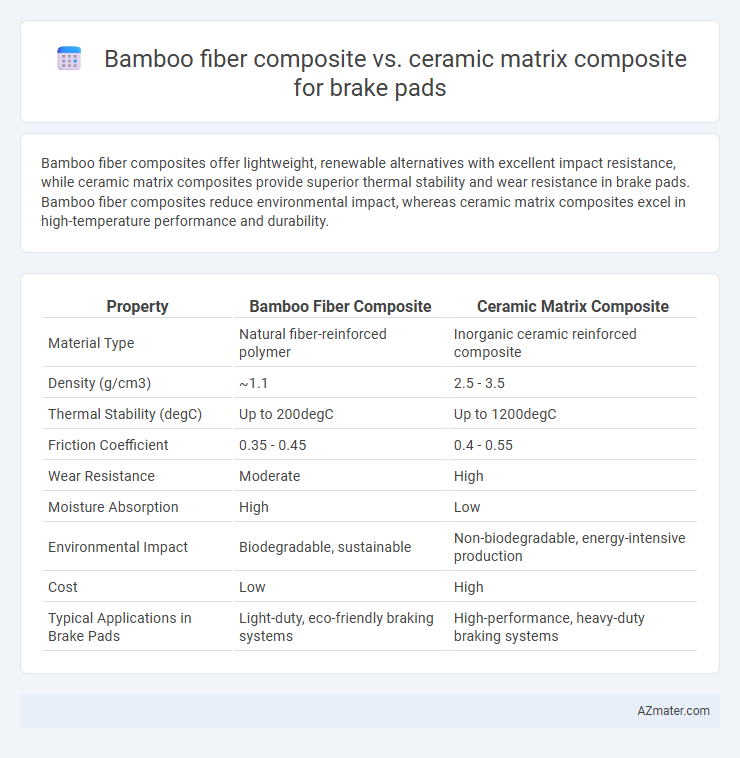Bamboo fiber composites offer lightweight, renewable alternatives with excellent impact resistance, while ceramic matrix composites provide superior thermal stability and wear resistance in brake pads. Bamboo fiber composites reduce environmental impact, whereas ceramic matrix composites excel in high-temperature performance and durability.
Table of Comparison
| Property | Bamboo Fiber Composite | Ceramic Matrix Composite |
|---|---|---|
| Material Type | Natural fiber-reinforced polymer | Inorganic ceramic reinforced composite |
| Density (g/cm3) | ~1.1 | 2.5 - 3.5 |
| Thermal Stability (degC) | Up to 200degC | Up to 1200degC |
| Friction Coefficient | 0.35 - 0.45 | 0.4 - 0.55 |
| Wear Resistance | Moderate | High |
| Moisture Absorption | High | Low |
| Environmental Impact | Biodegradable, sustainable | Non-biodegradable, energy-intensive production |
| Cost | Low | High |
| Typical Applications in Brake Pads | Light-duty, eco-friendly braking systems | High-performance, heavy-duty braking systems |
Introduction to Brake Pad Materials
Bamboo fiber composite brake pads offer lightweight, eco-friendly alternatives with high tensile strength and natural abrasion resistance, supporting sustainable automotive applications. Ceramic matrix composites (CMCs) provide superior thermal stability, wear resistance, and enhanced friction performance under high-temperature braking conditions, making them ideal for high-performance vehicles. Selecting between bamboo fiber and ceramic matrix composites depends on balancing cost, environmental impact, and performance requirements in brake pad manufacturing.
Overview of Bamboo Fiber Composites
Bamboo fiber composites offer a sustainable and lightweight alternative for brake pad materials, featuring high tensile strength and excellent fatigue resistance due to the natural fiber's inherent flexibility. These composites exhibit improved vibration damping and thermal stability, contributing to enhanced brake performance and reduced wear. Compared to ceramic matrix composites, bamboo fiber composites provide cost-effective manufacturing and lower environmental impact while maintaining adequate mechanical and thermal properties for automotive applications.
Overview of Ceramic Matrix Composites
Ceramic matrix composites (CMCs) consist of ceramic fibers embedded in a ceramic matrix, offering high-temperature resistance and excellent wear performance ideal for brake pads. Compared to bamboo fiber composites, CMCs provide superior thermal stability, reducing brake fade during intense braking conditions. Their enhanced hardness and low thermal expansion contribute to longer service life and consistent braking efficiency in automotive applications.
Material Composition and Structure
Bamboo fiber composites for brake pads consist of natural cellulose fibers embedded in a polymer resin matrix, providing lightweight and flexible reinforcement with high damping properties. Ceramic matrix composites feature ceramic fibers such as silicon carbide within a ceramic matrix, offering superior thermal stability, wear resistance, and hardness under extreme temperatures. The organic-inorganic structure of bamboo composites contrasts with the brittle yet thermally resilient structure of ceramic composites, influencing their performance and durability in braking applications.
Mechanical Performance Comparison
Bamboo fiber composite brake pads exhibit high tensile strength and improved impact resistance due to natural fiber reinforcement, offering lightweight and sustainable alternatives. Ceramic matrix composites (CMCs) demonstrate superior thermal stability, wear resistance, and compressive strength at elevated temperatures, making them ideal for high-performance braking systems. The mechanical performance of bamboo fiber composites is suitable for moderate load conditions, while CMCs excel under extreme mechanical and thermal stress, providing longer durability and consistent braking efficiency.
Thermal Stability and Heat Resistance
Bamboo fiber composites exhibit moderate thermal stability and heat resistance, suitable for low to medium temperature brake applications but prone to degradation above 300degC. Ceramic matrix composites (CMC) provide superior thermal stability and heat resistance, maintaining structural integrity and performance at temperatures exceeding 1000degC, making them ideal for high-performance and heavy-duty brake pads. The enhanced heat dissipation and oxidation resistance of CMCs result in longer lifespan and consistent braking performance under extreme thermal conditions compared to bamboo fiber composites.
Environmental Impact and Sustainability
Bamboo fiber composites exhibit superior sustainability due to their renewable, biodegradable nature and low carbon footprint compared to ceramic matrix composites, which rely on energy-intensive manufacturing and non-renewable raw materials. The production of bamboo fiber composites results in significantly lower greenhouse gas emissions and reduced waste generation, promoting eco-friendly brake pad solutions. Incorporating bamboo fibers also supports sustainable harvesting practices and carbon sequestration, enhancing the environmental benefits over conventional ceramic-based brake pads.
Cost and Manufacturing Considerations
Bamboo fiber composite brake pads offer significant cost advantages due to the low price and renewable nature of bamboo material, combined with simpler manufacturing processes involving molding and curing, resulting in faster production times and reduced energy consumption. In contrast, ceramic matrix composites require high-temperature sintering and complex fabrication techniques such as chemical vapor infiltration, contributing to higher production costs and longer lead times. Manufacturers aiming for cost-efficiency and sustainability often prefer bamboo fiber composites, while ceramic matrix composites are chosen for superior high-temperature performance despite their elevated manufacturing expenses.
Wear Rate and Longevity Analysis
Bamboo fiber composite brake pads exhibit a lower wear rate compared to traditional ceramic matrix composites due to the natural flexibility and toughness of bamboo fibers, which enhance impact resistance and reduce material degradation under friction. Ceramic matrix composites offer superior thermal stability and higher temperature resistance, contributing to longer functional longevity in high-performance braking applications, but often suffer from brittleness leading to micro-cracks and wear over extended use. Wear rate analysis reveals bamboo fiber composites maintain consistent performance over multiple braking cycles, while ceramic matrix composites require careful thermal management to prevent accelerated wear and mechanical failure.
Future Prospects and Industry Applications
Bamboo fiber composites offer lightweight, sustainable alternatives with high impact resistance and cost-effectiveness for brake pad manufacturing, while ceramic matrix composites provide superior thermal stability, wear resistance, and performance under extreme braking conditions in high-performance vehicles. The future of brake pad materials trends toward hybrid composites combining bamboo fibers with ceramic matrices to balance eco-friendliness and high durability, expanding applications in electric vehicles and aerospace braking systems. Industry adoption is accelerating as manufacturers prioritize reduced carbon footprints alongside enhanced thermal management and frictional properties, driving innovation and regulatory compliance in automotive and transportation sectors.

Infographic: Bamboo fiber composite vs Ceramic matrix composite for Brake pad
 azmater.com
azmater.com